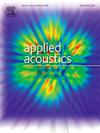Vibro-acoustic-modulation pseudo-force spectrum: A new concept for localizing “breathing” debondings in laminated beams
IF 3.4
2区 物理与天体物理
Q1 ACOUSTICS
引用次数: 0
Abstract
Laminated beams, although extensively utilized in engineering structures, are vulnerable to local debondings. When subjected to a vibro-acoustic excitation, the opening-closing motion of a “breathing” debonding generates contact-induced nonlinearity. Such nonlinearity allows for manifesting the presence and evaluating the extent of debonding by sideband harmonics, known as the vibro-acoustic modulation (VAM) technique. To further sharpen the capability of the VAM technique in localizing debondings, this study incorporates the emerging concept of nonlinear pseudo-force (NPF) into the VAM technique, producing a new concept of VAM pseudo-force spectrum (VAM-PFS). As NPFs exist exclusively within debonding regions, the VAM-PFS built on a group of NPFs linked to the neighboring sideband harmonics can serve as an ideal indicator for localizing debondings. Notably, the NPFs are reconstructed directly from operating deflection shapes (ODSs) associated with the sideband harmonics, eliminating the need for prior knowledge of material and structural parameters. Additionally, to suppress interference in the VAM-PFS from measurement noise, multiscale analysis is applied to the measured sideband ODSs. The VAM-PFS is numerically proven using the finite element method, and its applicability is experimentally validated on steel laminated beams with through-width debondings, whose sideband ODSs are measured via laser scanning using a scanning laser vibrometer. The results demonstrate that VAM-PFSs are ideal indicators to manifest the presence of “breathing” debondings and characterize their locations and sizes.
振动声调制伪力谱:层合梁“呼吸”脱粘的新概念
叠层梁虽然广泛应用于工程结构中,但存在局部脱粘的问题。当受到振动声激励时,“呼吸”脱粘的开合运动产生接触诱发非线性。这种非线性允许通过边带谐波显示存在并评估脱粘的程度,称为振动声调制(VAM)技术。为了进一步提高VAM技术的局部脱粘能力,本研究将新兴的非线性伪力(NPF)概念引入到VAM技术中,提出了VAM伪力谱(VAM- pfs)的新概念。由于npf只存在于脱键区域内,因此基于一组与相邻边带谐波相连的npf构建的VAM-PFS可以作为定位脱键的理想指标。值得注意的是,npf是直接从与边带谐波相关的工作挠度形状(ods)重建的,从而消除了对材料和结构参数先验知识的需要。此外,为了抑制测量噪声对VAM-PFS的干扰,对测量的边带损耗进行了多尺度分析。采用有限元方法对VAM-PFS进行了数值验证,并对具有通宽脱粘的钢层合梁的适用性进行了实验验证,采用扫描激光测振仪对其边带ods进行了测量。结果表明,vam - pfs是显示“呼吸”脱粘存在的理想指标,并表征其位置和大小。
本文章由计算机程序翻译,如有差异,请以英文原文为准。
求助全文
约1分钟内获得全文
求助全文
来源期刊

Applied Acoustics
物理-声学
CiteScore
7.40
自引率
11.80%
发文量
618
审稿时长
7.5 months
期刊介绍:
Since its launch in 1968, Applied Acoustics has been publishing high quality research papers providing state-of-the-art coverage of research findings for engineers and scientists involved in applications of acoustics in the widest sense.
Applied Acoustics looks not only at recent developments in the understanding of acoustics but also at ways of exploiting that understanding. The Journal aims to encourage the exchange of practical experience through publication and in so doing creates a fund of technological information that can be used for solving related problems. The presentation of information in graphical or tabular form is especially encouraged. If a report of a mathematical development is a necessary part of a paper it is important to ensure that it is there only as an integral part of a practical solution to a problem and is supported by data. Applied Acoustics encourages the exchange of practical experience in the following ways: • Complete Papers • Short Technical Notes • Review Articles; and thereby provides a wealth of technological information that can be used to solve related problems.
Manuscripts that address all fields of applications of acoustics ranging from medicine and NDT to the environment and buildings are welcome.
 求助内容:
求助内容: 应助结果提醒方式:
应助结果提醒方式:


